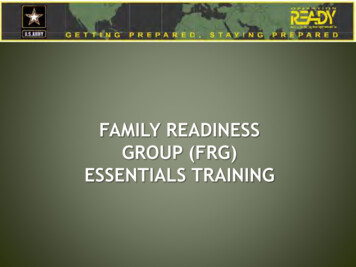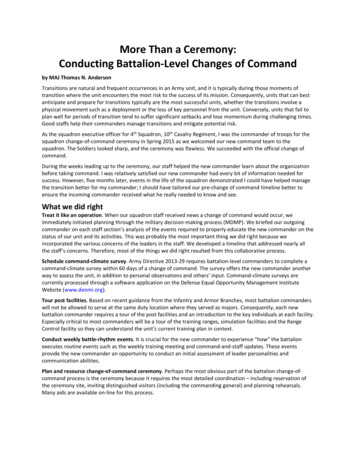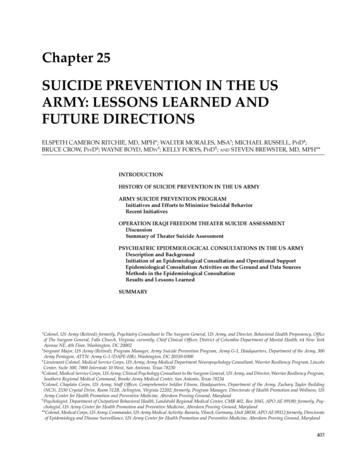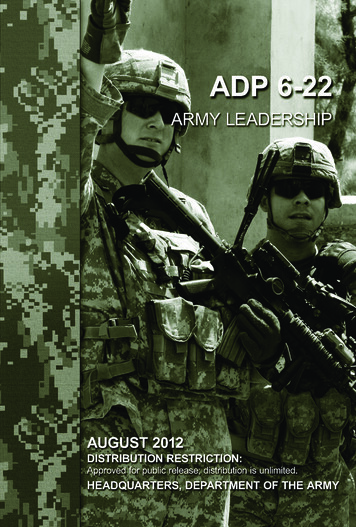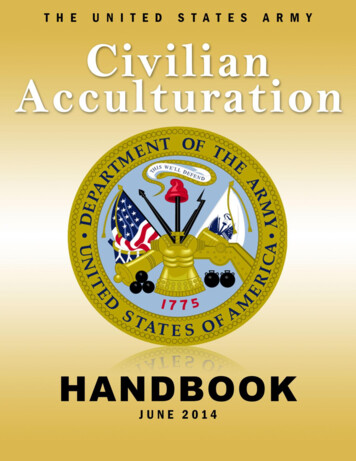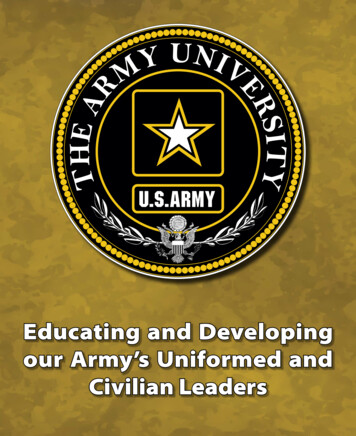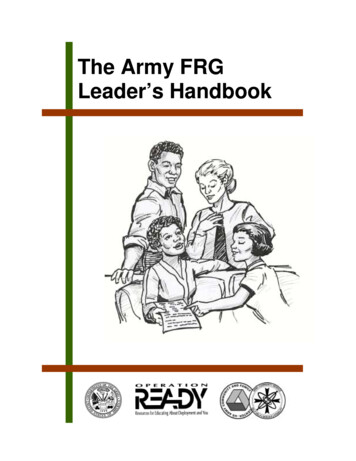
Transcription
The Army FRGLeader’s Handbook
The Army FRG Leader’s HandbookA Handbook for FRG Leaders in the Active Army,the Army National Guard, and the Army ReserveThis handbook is a revision and expansion of the Operation READY (Resources forEducating about Deployment and You) curriculum developed under a contract withHeadquarters, Department of the Army, Community and Family Support Center, and theTexas Cooperative Extension of the Texas A&M University System.Grant Administrator and Project Directorfor Texas Cooperative ExtensionNancy GranovskyProject ManagerGranville E. (Gene) TysonEditor and DesignSusan LeeProduction CoordinatorDiane WisneskiGraphic DesignGayle E. BehrleCover IllustratorEmma StarkOperation READY:Resources for Educating About Deployment and YouTexas Cooperative ExtensionThe Texas A&M University Systemin cooperation withThe United States ArmyCommunity and Family Support Centerand Army Community Service2002The Army FRG Leader’s Handbook2
ABOUT THIS HANDBOOKThe Army FRG Leader’s Handbook was designed to assist Active and ReserveComponent Family Readiness Group (FRG) leaders in their mission of helping Armyfamilies toward greater self-sufficiency. Senior Army leadership has recognized thatsoldier readiness is inextricably linked to family self-sufficiency. An effective FRGcontributes immeasurably to the self-sufficiency of families in the unit, and it willcontribute to unit readiness.Each workshop participant should receive a copy of the FRG Handbook, which consistsof the first nine chapters of this document (pages1–152). Additionally, the trainer isprovided with a series of lesson plans built around PowerPoint slides, which arepertinent to each of the chapters in the handbook. The lessons are designed to bepresented in two four-hour workshop sessions by the FRG leader, ACS staff member,or Guard/Reserve family program staff. However, the lessons may be taughtindividually, if necessary. Handouts and supplemental materials are provided with eachlesson. The Operation READY video, Family Readiness Groups—A Place to Belong,may be used as an introduction to the workshop; a copy of the video’s script is alsoincluded. Lastly, a bibliography is included that contains additional references, websites,and supplemental materials.ACKNOWLEDGMENTSA number of people contributed to this handbook, but foremost among those are Mr.James Peters and Mrs. Becky Poppelton. Their work as volunteers in the Mobilizationand Deployment section of Army Community Service at Fort Hood, Texas, has beeninspiring and invaluable. These individuals shared their FRG publication for trainingleaders, which has been used to develop this handbook into a comprehensive, reliable,and in-depth reference for FRG leaders.The Army FRG Leader’s Handbook3
OPERATION READY MATERIALSThe Operation READY curriculum is a series of training modules, videotapes, andresource books published for the Army as a resource for Army Community Service(ACS), State Family Program Coordinators (SFPC), and Army Reserve FamilyReadiness Program (FRP) staff in training Army soldiers and families who are facedwith deployments.This revised curriculum includes the following training modules and reference materials:# The Army Family Readiness Handbook# The Army Leaders’ Desk Reference for Soldier/Family Readiness (new)# The Soldier/Family Deployment Survival Handbook (new)# The Army FRG Leader’s Handbook# Family Assistance Center# Predeployment and Ongoing Readiness# Homecoming and ReunionVideos developed for the Operation READY curriculum by University of California–Riverside Cooperative Extension, to supplement the above materials are:# Army Community Service: To Get the Most Out of Life, Think ACS (new)# Introduction to Operation READY (new)# Family Assistance Center# Family Readiness Groups—A Place to Belong# Practical Readiness—Smart Ways to Minimize Deployment Hassles# Coping with Stress# Making Your Reunion WorkChildren’s Workbooks for use by parents with their children.These materials have been distributed to all U.S. Army installations throughout theworld, as well as to U.S. Army Reserve and National Guard commands. The materialsare distributed in hard copy form as well as stored on CD-ROM disks. They are alsoavailable through the virtual Army Community Service website, www.goacs.org. Forcopies of the above materials, check with your local Army Community Service,Mobilization and Deployment office, SFPC and FRP offices.The Army FRG Leader’s Handbook4
The Army FamilyReadiness GroupLeader’s HandbookThe Army FRG Leader’s Handbook5
ACKNOWLEDGMENTSA number of people contributed to this handbook, but foremost among those are Mr.James Peters and Mrs. Becky Poppelton. Their work as volunteers in the Mobilizationand Deployment section of Army Community Service at Fort Hood, Texas, has beeninspiring and invaluable. These individuals shared their FRG publication for trainingleaders, which has been used to develop this handbook into a comprehensive, reliable,and in-depth reference for FRG leaders.The Army FRG Leader’s Handbook6
TABLE OF CONTENTSChapter 1. Family Readiness Group Overview .11Introduction.11FRG Definition and Mission .11Goals of the FRG.12Do We Really Need FRGs? .13The FRG—What’s in It for Us? .13FRG Structure.15The Unit-Level FRG Structure.16Battalion–Level and Higher-Level Family Readiness Support.19Family Readiness Responsibilities.20The Five Essential Ingredients of an Effective FRG .22Chapter 2. Leadership for Effective FRGs .24What Kind of Leader Does It Take? .24Leadership Goals.25Military Role in the FRG.27Teamwork—Expectations of the FRG Leader and Unit Commander .28Leadership Styles .30Supervising People.31Leaders Actively Promote Diversity .32Making Decisions and Leading Decision Making .33Preparing and Giving Presentations .34FRG Leadership Checklist .36Chapter 3. Building Your FRG – Getting Started .37Are You Ready? .37How Do You Get Started? .37Key Tasks Of An Effective FRG.39Plan The First FRG Meeting .39What Should the First Meeting Accomplish?.39Suggested Outline for Planning the First FRG Meeting.41FRG Volunteers .45Communication.46Conducting The Meeting.48Encourage Participation.49GROUP DYNAMICS.50Resistance To Change .51Resolving Conflict .52Childcare Issues .53The Army FRG Leader’s Handbook7
Chapter 4. Building Your FRG – Working With Volunteers.55Volunteers Make a Difference!.55Brief History of Army Volunteers .55Volunteer Service .56Volunteer Training .56Volunteer Responsibilities.58Volunteer Rights .60Volunteer Records .60Volunteer Code of Ethics .62Volunteer Recognition.63Typical FRG Volunteer Positions .66Meaningful Assignments—A Sense of Purpose and Contribution.67FRG Job Descriptions.67Two Critical FRG Positions .68Volunteer Resources .86Chapter 5. Building an Effective FRG – Preparing to Contact Soldiersand Families .87Welcoming New Soldiers and Families .87FRG Membership Roster .88The FRG Phonetree .88How Does the Phonetree Work?.89Benefits of an Effective FRG Phonetree .91How the Phonetree POC Gets Started.91Six Types of Phone Calls.93Basic Rules of Crisis Intervention .97Brief Descriptions of Post Community Resources.100Chapter 6. Running an Effective FRG - Communications.101Newsletters.101Does the FRG Need a Newsletter?.101What Kind of Newsletter Should an FRG Have?.102Getting Organized for the Newsletter.103Designing the Newsletter .104Editing .104Layout.105Proofreading, Illustrations, Final Copy, and Pasteups.106Publishing the Newsletter .106FRG Website .107Media.108Being Interviewed by the Media .108Chapter 7. Running an Effective FRG – Special Events.110The Army FRG Leader’s Handbook8
Keep the Fun Times Coming! .110Choosing Fun Events .110What Are Some Fun Things to Do? .111The Planning Phase .112Making it Happen.115Finally, the After Action Report .115Safety and Health during FRG Events .117Food and Water Sanitation .117Protection from Biting Creatures .117Protection from Heat and Sun.118Water Safety.118Driver/Passenger/Pedestrian Safety .119Other Safety Issues .119Chapter 8. Running an Effective FRG – Money Matters.120Funding the FRG .120Establishing an FRG Fund Account .122Balance Sheet for Managing the FRG Fund .125Appropriate Uses of FRG Funds.126FRG Fundraisers .126Authorized Fundraisers.126Prohibited Fundraising Activities .127Obtaining Permission to Have a Fundraiser.127Safety at Fundraising Activities .129Things to Remember When Fundraising.129Chapter 9. The FRG – Bringing it All Together .131A Calm and Well-Planned Approach.131Improving An Existing FRG.132Problem Solving.133Prevalent Problems in Weak FRGs .137Getting Families and Soldiers Ready .139Sustaining the FRG during a Mission.141Children’s Issues during a Mission.142Maintaining the FRG after the Mission .143Avoiding Burnout .143FRG Checklist.146Bibliography and Websites .149The Army FRG Leader’s Handbook9
List of FiguresFigure 1. Relationship between the Chain of Command and Chain of Concern17Figure 2. Family and Soldier Readiness Structure18Figure 3. Soldier-Family Readiness Flowchart19Figure 4. Sample FRG Information Survey43 - 45Figure 5. Typical FRG Organizational Structure46Figure 6. Sample FRG Volunteer Code of Ethics63Figure 7. Sample FRG Phonetree89Figure 8. Sample Phonetree Log Form90Figure 9. Sample POC Problem Resolution Form98Figure 10. Decision Diagram for Helping a Distressed Person99Figure 11. Sample Event Planning Form114Figure 12. Sample After Action Report Form116Figure 13. Sample FRG Fund Account Authorization Letter124Figure 14. Sample Permission Letter for Fundraiser128Figure 15. Problem-Solving Steps133Figure 16. Sample Problem-Solving Table136The Army FRG Leader’s Handbook10
Chapter 1Family Readiness Group OverviewCHAPTER 1. FAMILY READINESS GROUP OVERVIEWIntroductionThis Army FRG Leader’s Handbook provides an overview of the Family ReadinessGroup (FRG); its purpose, structure, and function; command and memberresponsibilities; key leader job descriptions; and other aspects of building and leadingeffective FRGs. Its focus is on the essential ingredients and key tasks of effective FRGsand their importance in helping soldiers and families cope with the stresses of militarylife and in building cohesive families in the Army. In a very real sense, FRGs can helpsoldiers and their leaders with the military mission, too. This handbook explains how.FRG Definition and MissionThe Family Readiness Group, formerly known as the Family Support Group (FSG), is aconcept that had early roots among Army families, who banded together during war ortours overseas or other isolated locations, to provide information, moral support, andsocial outlets to their members. The Army focused sharply on family readiness as aresult of lessons learned during the 1990–91 Gulf War. On 1 June 2000, Department ofthe Army renamed it Family Readiness Group to emphasize the need for readiness andself-sufficiency among Army families in the modern Army.Paraphrasing DA Pamphlet 608-47, the FRG is “an organization of family members,volunteers, soldiers, and civilian employees belonging to a unit/organization whotogether provide an avenue of mutual support and assistance and a network ofcommunication among the members, the chain of command, and communityresources.” Unit FRGs consist of all assigned and attached soldiers (married andsingle), their spouses, and children. This membership is automatic, and participation isvoluntary. Extended families, fiancées, boy/girlfriends, retirees, DA civilians, and eveninterested community members can and should be included, as well.The FRG mission is “to assist commanders in maintaining readiness of soldiers,families, and communities within the Army by promoting self-sufficiency, resiliency, andstability during peace and war.”The Army FRG Leader’s Handbook11
Goals of the FRGBased on the FRG mission statement, the FRG may fill many important roles,including:# build soldier and family cohesion and morale;# prepare soldiers and families for separation during deployments and, later, for thestresses of reunion;# reduce soldier and family stress;# reduce the commander’s and other leaders’ workloads;# help soldiers focus on their mission during deployments;# help families become more self-sufficient;# provide an avenue for sharing timely, accurate information; and# promote better use of post and community resources.Later, these roles will be translated into the key tasks that effective FRGs plan andimplement for their soldiers and families.The FRG is:# an information conduit;# a welcoming organization;# a self-help, referral organization;# a source of social support and group activities; and# a unit family dedicated to achieving social and military goals.The FRG is not:# a babysitting service,# a taxi service,# a financial institution,# a professional counseling agency, or# another military organization.The Army FRG Leader’s Handbook12
Do We Really Need FRGs?Many experienced soldiers and spouses firmly believe that FRGs are important.Consider the following facts, based on recent research by the Army Community andFamily Support Center, about the Army family:# The ratio of immediate family members to soldiers is about 60 to 40.# About 60 percent of soldiers are married.# The ratio of children to soldier-parents is about two to one.# About 6 percent of soldier-parents are single.# Single soldiers have families somewhere.# Families help soldiers make career decisions.# Finally, the single most important concern of soldiers is that their families will betaken care of, both during peace and deployments.So, yes, effective FRGs are important for soldiers and families. To create effectiveFRGs, the five essential ingredients—leadership, organization, training, fun activities,and communication—must be built into the unit FRGs. Of course, this is easier saidthan done, but it’s a basic fact that must be embraced by every leader—both militaryand spouse—if soldiers and families are to be successful.“THE SOLDIER IS AN EXTENSION OF THE FAMILY .”The old saying about the Army family, “If the Army wants you to have a family,they’ll issue you one!” is no longer operative in today’s Army. And the family isno longer seen as an extension of the soldier; now it’s quite the opposite.Today, clearly, we know soldiers are extensions of their families. So ourchanging Army and its missions point to the critical need for strong FRGs—effective FRGs—to help enhance soldier and family morale and success athome and at work. Effective FRGs can even help our soldiers accomplishmilitary missions.—Mr. David White, Chief, U.S. Army Family Liaison OfficeThe FRG—What’s in It for Us?For spouses and family members, the FRG gives a sense ofbelonging to the unit and the Army community—the Army Family. Itprovides a way to develop friendships, share important information,obtain referrals to needed Army resources, and share moral supportduring unit deployments. For the long-term, involvement in FRGactivities can foster more positive attitudes among Army families andprovide a better understanding of military life, the unit, and its mission.The Army FRG Leader’s Handbook13
For soldiers, peace of mind—soldiers can be assured that their familymembers will be more self-sufficient and will have reliable and friendlysupport while they are deployed. This peace of mind can help soldiersfocus on their work, perform better, relate better to other soldiers, andbe safer while they’re on a training or real-world mission.For commanders, the unit FRG helps to lighten their workload, especially in the area ofsoldier and family readiness goals. The FRG can enhance camaraderie and unitreadiness by promoting self-reliance and by helping soldiers and family members toidentify closely with the unit.For the military and civilian communities, a wellestablished FRG program can help forestall seriousfamily problems (such as family violence, substanceabuse, juvenile delinquency, child abuse, etc.) thatweaken Army families and place heavy demands oncommunity service agencies. FRGs refer familymembers to military or civilian community resources and help families develop copingskills and stronger family units. Effective FRGs also provide a positive environment fordiverse cultures to thrive together and to truly become one Army family—an Army ofOne.For the Army, successful FRG programs, combined with ample andavailable community resources, help the Army achieve its primary goals—including the all-important goal of attracting and retaining high-qualitysoldiers and families in the Army.For the Army Family and society as a whole, peace of mind; togetherness; pride inourselves as individuals, families, units, and a nation of diverse cultures; and confidencethat our Army can promote a better and safer world.The Army FRG Leader’s Handbook14
THE FRG AND THE MILITARY MISSIONCommanders and other leaders at all levels and spouses in leadership rolesshould be keenly aware that FRGs can help build better unit families and canhelp with military missions, as well. How could this be true? Simply put, wellorganized and effective FRGs help improve morale among soldiers and theirfamilies. In turn, soldiers and their leaders are more focused on theirmissions, safer, and not as worried about their families when the unit istraining or engaged in real-world missions.FRG StructureFRGs can be structured in a number of ways, based on the type of unit, its mission, theneeds of the soldiers and family members, and sometimes local policies. The FRGstructure outlined in this handbook is based on active Army units co-located withheadquarters on a permanent garrison. It can also be adapted for use in commands,both active and reserve, which are split among distant posts, sometimes in differentstates and even different countries.FRGs typically are organized at two or more levels to form a support network for unitsoldiers and families:# The unit-level FRG (and sometimes in separate detachments) is the “grassroots”organization for soldier and family readiness in the Army and, therefore, willreceive major emphasis in this handbook. Its main function is to build a friendlysupport and information network for the members before, during, and afterdeployments.The battalion commander and key staff and families generally are members of theheadquarters unit FRG. Occasionally, though, a single central FRG may exist atbattalion level.# The battalion-level FRG serves in an advisory and support capacity for unit-levelFRGs. The steering committee interfaces regularly with unit-level FRGs, ensuringthat the battalion and higher command family readiness goals are met.By regulation, the unit commander is responsible for establishing and supporting theunit FRG. Ideally, family readiness is managed from the top, and commanders have unitfamily readiness performance goals they must meet. Clearly, they can’t meet thosegoals alone; they must identify capable spouse leadership and delegate clearresponsibilities and the authority that goes with them to the spouse volunteers. Militarymembers should not be FRG leaders. Commanders should encourage participationby all unit soldiers and families in FRG activities, which is best accomplished in aThe Army FRG Leader’s Handbook15
friendly, informal setting. Face it—soldiers of all grades will want to belong and will wanttheir families to participate if the FRG is relaxed, democratic, meaningful, and fun.Remember, soldiers neither need nor want “another army within the Army.”SELECTION OF FRG LEADERSThe FRG leader may be selected by the commander or elected by the FRGmembership. In turn, the FRG leader selects other volunteers or holdselections to fill key positions. The leadership structure of the FRG is discussedin detail later.The Commander Is Not the FRG LeaderThe unit commander—and actually, any soldier—should not fill the role ofFRG leader. Though responsible for the FRG by regulation, the commandermust delegate the position to a capable spouse volunteer because:# soldiers often deploy with the unit;# spouses need to train in FRG leadership positions;# FRG members are volunteers, and they will relate better to a volunteerleader;# soldiers do not want other soldiers giving orders to their spouses andchildren; and FRG members will be best served in a friendly, informalenvironment.Often, but not always, the FRG leader is the commander’s spouse because thecommander believes his/her spouse can best relate to the family readiness goals.However, every commander should consider what is best for the unit, the soldiers, thefamilies, and the mission. The commander must have clear family readiness goals andtake the initiative to ensure that they are met or exceeded by helping spouse leadersbuild and run an effective FRG.The Unit-Level FRG StructureAs stated, the primary emphasis of the FRG program is on the unit level, with supportand guidance from battalion-level leadership and above. There are two major supportcircles or chains associated with any FRG: the Chain of Command and the Chain ofConcern. The Chain of Command consists of military leaders and senior staff members,while the Chain of Concern is comprised of spouse volunteers, who assist the Chain ofCommand in supporting the unit FRG membership and achieving unit readiness goals.Figure 1 illustrates how these chains are related at the unit level.The Army FRG Leader’s Handbook16
Figure 1. Relationship between the Chain of Commandand Chain of Concern.The unit FRG structure is designed to promote communication of important informationand to encourage contact and mutual support among soldiers and family members.It is through this grassroots organization and its activities that family readiness andsoldier-family cohesion takes place. The unit FRG is normally the “lowest commondenominator,” and FRGs usually are not broken down into smaller units, such asplatoons. Cooperation and mutual support between the commander and the FRG leaderare critical. Likewise, the willing service of various volunteers, as shown in Figure 2, isindispensable to the FRG leader and the effectiveness of the FRG. An effective FRGinvariably has a strong, caring organization of military and volunteer leaders who workwell together for the common good. Chapter 2 discusses FRG leadership in depth.The Army FRG Leader’s Handbook17
Other Family Readiness Entities# Rear Detachment Officer (RDO)—a unit officer who acts as unitcommander in the rear when the unit is deployed.# Army Community Service (ACS) and other service organizations, onand off post, which assist soldiers and families.# Unit Chaplain—provides counseling on personal, family, and spiritualconcerns.# USAR Family Program Director—provides assistance, guidance, andsupport to soldiers and family members.# Army National Guard State Family Program Coordinator—providesassistance, guidance, and support to Guard members and their families.# Family Assistance Center (FAC)—a one-stop-shop set up to provideessential family services during a major deployment.Figure 2, Family and Soldier Readiness Structure, shows how these entitiesrelate to the FRG.Figure 2. Family and Soldier Readiness Structure.The Army FRG Leader’s Handbook18
Figure 3, Soldier-Family Readiness Flowch
Figure 7. Sample FRG Phonetree 89 Figure 8. Sample Phonetree Log Form 90 Figure 9. Sample POC Problem Resolution Form 98 Figure 10. Decision Diagram for Helping a Distressed Person 99 Figure 11. Sample Event Planning Form 114 Figure 12. Sample After Action Report Form 116 Figure 13. Sample FRG Fund Account Authorization Letter 124 Figure 14.

